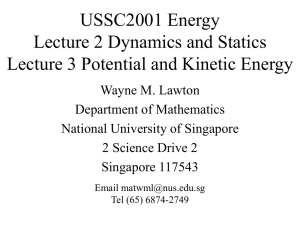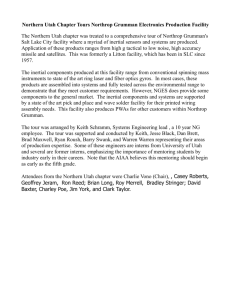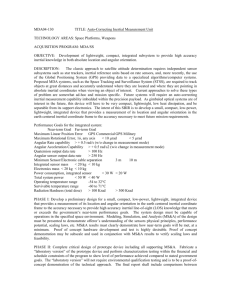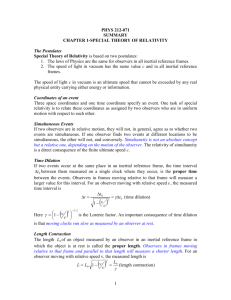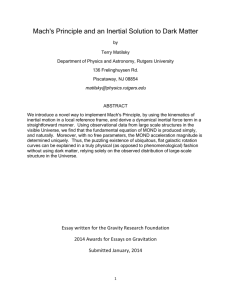Internat. J. Math. & Math. Sci. S0161171200001605 © Hindawi Publishing Corp.
advertisement
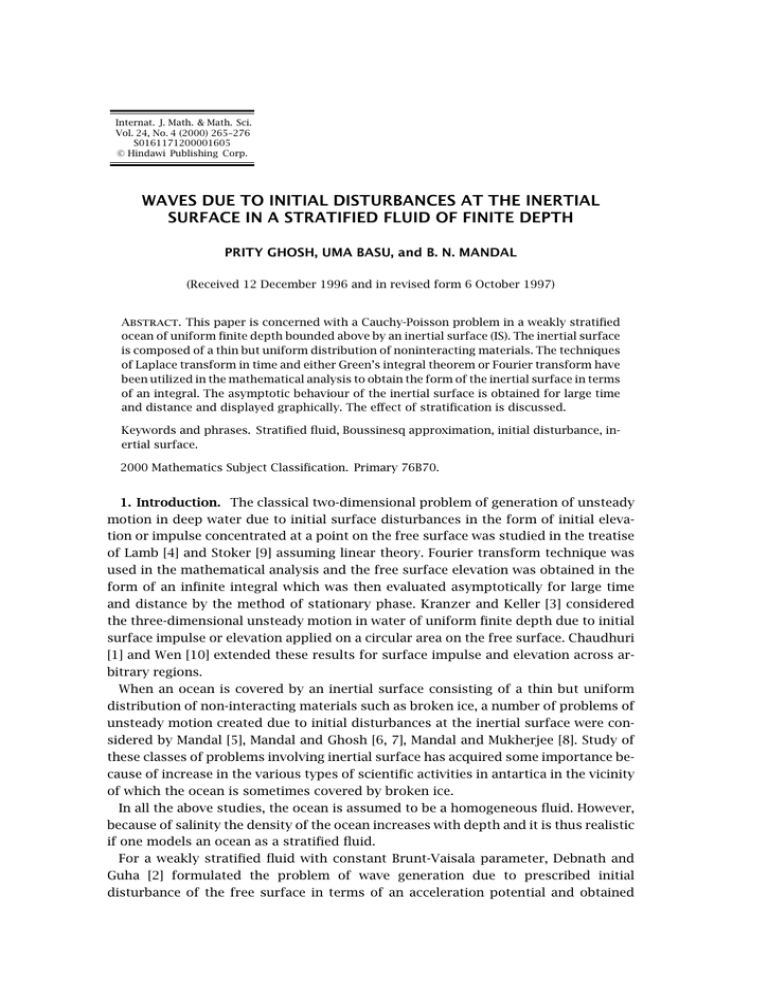
Internat. J. Math. & Math. Sci. Vol. 24, No. 4 (2000) 265–276 S0161171200001605 © Hindawi Publishing Corp. WAVES DUE TO INITIAL DISTURBANCES AT THE INERTIAL SURFACE IN A STRATIFIED FLUID OF FINITE DEPTH PRITY GHOSH, UMA BASU, and B. N. MANDAL (Received 12 December 1996 and in revised form 6 October 1997) Abstract. This paper is concerned with a Cauchy-Poisson problem in a weakly stratified ocean of uniform finite depth bounded above by an inertial surface (IS). The inertial surface is composed of a thin but uniform distribution of noninteracting materials. The techniques of Laplace transform in time and either Green’s integral theorem or Fourier transform have been utilized in the mathematical analysis to obtain the form of the inertial surface in terms of an integral. The asymptotic behaviour of the inertial surface is obtained for large time and distance and displayed graphically. The effect of stratification is discussed. Keywords and phrases. Stratified fluid, Boussinesq approximation, initial disturbance, inertial surface. 2000 Mathematics Subject Classification. Primary 76B70. 1. Introduction. The classical two-dimensional problem of generation of unsteady motion in deep water due to initial surface disturbances in the form of initial elevation or impulse concentrated at a point on the free surface was studied in the treatise of Lamb [4] and Stoker [9] assuming linear theory. Fourier transform technique was used in the mathematical analysis and the free surface elevation was obtained in the form of an infinite integral which was then evaluated asymptotically for large time and distance by the method of stationary phase. Kranzer and Keller [3] considered the three-dimensional unsteady motion in water of uniform finite depth due to initial surface impulse or elevation applied on a circular area on the free surface. Chaudhuri [1] and Wen [10] extended these results for surface impulse and elevation across arbitrary regions. When an ocean is covered by an inertial surface consisting of a thin but uniform distribution of non-interacting materials such as broken ice, a number of problems of unsteady motion created due to initial disturbances at the inertial surface were considered by Mandal [5], Mandal and Ghosh [6, 7], Mandal and Mukherjee [8]. Study of these classes of problems involving inertial surface has acquired some importance because of increase in the various types of scientific activities in antartica in the vicinity of which the ocean is sometimes covered by broken ice. In all the above studies, the ocean is assumed to be a homogeneous fluid. However, because of salinity the density of the ocean increases with depth and it is thus realistic if one models an ocean as a stratified fluid. For a weakly stratified fluid with constant Brunt-Vaisala parameter, Debnath and Guha [2] formulated the problem of wave generation due to prescribed initial disturbance of the free surface in terms of an acceleration potential and obtained 266 PRITY GHOSH ET AL. the free surface profile asymptotically for large time and distance far away from the region of disturbance. However, their modelling a deep ocean by a stratified fluid of infinite depth with constant Brunt-Vaisala parameter is questionable since the density at very large depth becomes very large even if the Brunt-Vaisala parameter is small. In the present paper, we study the problem of wave generation due to initial disturbances in a weakly stratified fluid of finite depth covered by an inertial surface. The initial disturbances are prescribed at the inertial surface. Assuming linear theory the problem is formulated in terms of pressure under Boussinesq approximations and constant but small Brunt-Vaisala parameter. By using Laplace transform technique, the initial value problem is reduced to a boundary value problem which is then solved by two methods, one based on an appropriate use of Green’s integral theorem and the other on Fourier transform. The form of the inertial surface is then obtained in terms of an integral. This integral is evaluated asymptotically for large times and distances by the method of stationary phase when the initial disturbances at the inertial surface is concentrated at a point taken as the origin. The asymptotic form of the inertial surface profile is depicted graphically and compared with the result for an ideal fluid covered by an inertial surface. It is found that the effect of weak stratification is not of much significance. 2. Formulation of the problem. We consider an incompressible inviscid weakly stratified fluid of uniform finite depth h covered by an inertial surface composed of a thin but uniform distribution of disconnected floating materials of area density ρ0 (0) ( ≥ 0), where ρ0 (0) is the density of the fluid at the top. It may be noted that = 0 corresponds to a fluid with a free surface. We choose a rectangular cartesian coordinate system in which the y-axis is taken vertically downwards into the fluid, y = 0 is the position of the inertial surface at rest. The motion in the fluid is generated due to an initial disturbance prescribed on the inertial surface in the form of an initial depression of the inertial surface or initial impulse. We assume the resulting motion to be two-dimensional. We denote by p(x, y, t) and ρ(x, y, t) the perturbed pressure and density of the fluid, respectively, while ρ0 (y) denotes the density of the fluid at rest, u(x, y, t) and v(x, y, t) are respectively, the horizontal and vertical components of velocity. Under the assumption of linear theory the relevant equations satisfied in the fluid region are ux + vy = 0, ρt + vρ0 (y) = 0, ρ0 ut = −px , ρ0 vt = −py + gρ. (2.1) Combining the kinematic and dynamic conditions at the inertial surface, we find p − py = mg + Π − gρ − gρ0 η on y = 0, t > 0, (2.2) where η(x, t) is the depression of the inertial surface, g is the gravity and Π is the atmospheric pressure. The initial conditions are u = v = 0, at t = 0 η(x, t) = η0 (x) at t = 0, where η0 (x) is the prescribed initial depression of the inertial surface. (2.3) WAVES DUE TO INITIAL DISTURBANCES AT THE INERTIAL SURFACE . . . 267 Let p̄(x, y; s), η̄(x; s), ρ̄(x, y; s), and v̄(x, y; s) denote the Laplace transform of p(x, y, t), η(x, t), ρ(x, y, t), and v(x, y, t) in time, respectively. Under Boussinesq approximation, equations (2.1) produce p̄xx + λ2 p̄yy = 0, 0 ≤ y ≤ h, −∞ < x < ∞, (2.4) where λ = s/(s 2 + N 2 )1/2 is chosen such that Re λ > 0, and N2 = g ρ (y) ρ0 0 (2.5) is the Brunt-Vaisala parameter which is assumed to be constant and small. The smallness of N characterizes weakly stratified fluid. We now solve (2.4) along with the boundary conditions sgρ0 (0)η0 (x) s2 p̄(x, 0; s) − g + s 2 p̄y = − 2 λ λ2 p̄y = 0 on y = h. on y = 0, (2.6) p̄(x, y; s) is obtained in the next section by employing two methods, one based on an appropriate use of Green’s integral theorem and the other on Fourier integral transform. 3. Methods of solution 3.1. Method based on Green’s integral theorem. We use the transformation x = X, y = λY and denote P̄ (X, Y ) = p̄(X, λY ), then P̄ (X, Y ) satisfies ∇2 P̄ = 0 in 0 ≤ Y ≤ h , −∞ < X < ∞, λ (3.1) with sgρ0 (0)η0 (X) s2 P̄ (X, 0; s) − g + s 2 P̄Y = − λ λ h P̄Y = 0 on Y = = h . λ on Y = 0, (3.2) The boundary value problem described by (3.1) and (3.2) is now solved by an appropriate use of Green’s integral theorem to the functions G(X, Y ; X , Y ; s) and P̄ (X, Y ), where G satisfies ∇2 G = 0, 0 ≤ Y ≤ h except at X , Y , s2 G − g + s 2 GY = 0 on Y = 0, λ 2 2 1/2 → 0, G → ln R as R = X − X + Y − Y GY = 0 on Y = h , G → 0 as R → ∞. (3.3) 268 PRITY GHOSH ET AL. Then, G(X, Y ; X , Y ; s) can be obtained as G X, Y ; X , Y ; s = U X, Y ; X , Y − 2 ∞ 0 cosh k h − Y cosh k h − Y λµ 2 cos k X − X dk, 2 2 D(k) s + λµ k sinh kh (3.4) where R U X, Y ; X , Y = ln − 2λ R ∞ 0 cosh k h − Y cosh k h − Y D(k) exp − kh sinh kY sinh kY cos k X − X + dk k cosh kh (3.5) with R = X − X 2 2 1/2 + Y +Y , D(k) = cosh kh + kλ sinh kh , µ2 = (3.6) gk sinh kh . D(k) (3.7) Thus we find P̄ X , Y = gρ (0)s 0 π g + s 2 λ ∞ −∞ G X, 0; X , Y ; s η0 (X) dX. (3.8) Using (2.4) and reverting to the original variables we find that y p̄(x, y) ≡ P̄ x, λ gρ0 (0)s ∞ cosh k h − y/λ ∞ =− η0 X cos k x − X dX dk. Π D(k) s 2 + λµ 2 0 −∞ (3.9) 3.2. Method based on Fourier transform technique. Employing Fourier transform in x, the boundary value problem described by (2.4) and (2.6) reduces to 2 ¯ = 0, 0 ≤ y ≤ h, ¯ (y) − ξ p̄ p̄ λ2 s2 ¯ ¯ (y) = − sgρ0 (0)η̄0 (ξ) p̄ − g + s 2 p̄ λ2 λ2 ¯ (y) = 0 p̄ on y = h, (3.10) on y = 0, (3.11) (3.12) ¯ ≡ p̄ ¯(ξ, y; s) and η̄0 (ξ) are the Fourier transform of p(x, y; s) and η0 (x), where p̄ respectively. Equation (3.10) is an ordinary differential equation and its solution satisfying (3.11) and (3.12) is given by ¯ = −sgρ0 (0)f (ξ; y)η̄0 (ξ), p̄ (3.13) WAVES DUE TO INITIAL DISTURBANCES AT THE INERTIAL SURFACE . . . 269 where f (ξ; y) = cosh(ξ/λ)(h − y) , D(ξ) s 2 + λµ 2 (ξ) (3.14) so that f (ξ; y) is an even function of ξ. Using Fourier inversion, we find p̄(x, y), which is the same as given by (3.9). Now η̄(x; s) can be expressed in terms of p̄(x, y; s) given by 1 ∂ p̄ η̄(x; s) = (x, 0; s) − p̄(x, 0; s) (3.15) λ2 gρ0 ∂y so that, after using (3.9), we find ∞ 1 ∞ s η̄(x; s) = η0 X cos k x − X dX dk. π 0 s 2 + λµ 2 −∞ (3.16) By Laplace inversion, equation (3.16) will produce η(x, t) in principle. Now let us choose the initial displacement of the inertial surface to be concentrated at the origin, then η0 (X ) is taken as l2 δ(x), where l is a typical length, then s l2 ∞ cos kx dk (3.17) η̄(x; s) = π 0 s 2 + λµ 2 which, when written fully, is equivalent to 1/2 1/2 s 1 + N 2 /s 2 + ks tanh kh 1 + N 2 /s 2 l2 ∞ η̄(x; s) = cos kx dk. π 0 s 2 1 + N 2 /s 2 1/2 + ks 2 + gk tanh kh 1 + N 2 /s 2 1/2 (3.18) For the purpose of Laplace inversion, we note that s = ±iN are not branch points. This can be ascertained by noting that an even function of (1 + N 2 /s 2 )1/2 results after expanding the hyperbolic functions. Thus the only contribution to the Laplace inversion integral comes from the zeros of the denominator in the complex s-plane. The denominator has no real zero, and the only zeros are purely imaginary given by s = ±iw(k), (3.19) where w(k) > N and w 2 (k) = 2gk tanh kh + N 2 (1 − 2kh/sinh 2kh) + O N4 . 2(1 + k tanh kh) Thus, η(x, t) = where 2l2 π ∞ 0 F (k) cos w(k)t cos kx dk, G(k) 1/2 kh w 2 − N 2 , tanh F (k) = w − N + kw w − N w 1/2 2 kh w 2 − N 2 2 2 2 1/2 tanh G(k) = 2w − N + 2kw w − N w 1/2 kh w 2 − N 2 gk . + k − 2 N 2 kh sech2 w w 2 2 2 2 1/2 (3.20) (3.21) (3.22) 270 PRITY GHOSH ET AL. Thus the depression of the inertial surface is obtained in terms of an infinite integral. We note that in the absence of stratification, N = 0, and for deep water (3.21) produces η(x, t) = l2 π π 0 cos gk 1 + k 1/2 t cos kx dk, (3.23) which coincides with the result obtained by Mandal [5] earlier except for the scaling factor l2 . In (3.21) we use the non-dimensional substitutions x̃ = x/l, t̃ = (g/l)1/2 t, to obtain the non-dimensional form of the inertial surface depression as 1/2 η(x, t) 2l ∞ F (k) l = cos w(k) t̃ cos lkx̃ dk. (3.24) η̃ x̃, t̃ ≈ l π 0 G(k) g In the next section, asymptotic form of η̃(x̃, t̃) will be obtained for large x̃ and large t̃ such that x̃/t̃ remains finite. 4. Asymptotic expansion. To obtain the asymptotic form of η̃(x̃, t̃), we use the method of stationary phase. Now (3.24) can be written in the equivalent form ∞ 1/2 l F (k) klx̃ l exp it̃ w(k) + η̃ x̃, t̃ = 2π 0 G(k) g t̃ 1/2 l klx̃ + exp − it̃ w(k) + g t̃ (4.1) 1/2 l klx̃ + exp it̃ w(k) − g t̃ 1/2 l klx̃ dk. + exp − it̃ w(k) − g t̃ Let 1/2 l klx̃ φ(k) = φ k; x̃, t̃ = w(k) . − g t̃ (4.2) The first two integrals in (4.1) have no stationary point in the range of integration so that they do not contribute. The third and fourth integrals have stationary points given by φ (k) = 0. Now (4.3) 1/2 h 1/2 x̃ N 2h x̃ ≡l M− , 1+ − φ (0) = l l 3g t̃ t̃ where h M = l 1/2 N 2h 1+ 3g 1/2 , φ (∞) = − x̃ . t̃ (4.4) (4.5) WAVES DUE TO INITIAL DISTURBANCES AT THE INERTIAL SURFACE . . . 271 Also we have verified that φ (k) < 0 for 0 < k < ∞ so that φ (k) is monotone decreasing for 0 < k < ∞. Now for x̃/t̃ > M, both φ (0) and φ (∞) are negative. Hence there is no zero of φ (k) for 0 < k < ∞ so that there is no stationary point in this case. However, for x̃/t̃ < M, φ (0) is positive while φ (∞) is negative and since φ (k) is a monotone decreasing function for k > 0, φ (k) has a unique zero in (0, ∞) so that there exists only one stationary point at k = k0 , say. Finally when x̃/t̃ = M, φ (0) = 0 so that there is a stationary point at k = 0. But as φ (0) = ∞, it gives a smaller contribution than the x̃/t̃ < M case, so that its contribution can be neglected. Now applying the method of stationary phase to the third and fourth integrals and combining we find l η̃(x̃, t̃) ≈ π 2π l3/2 g 1/2 t̃ φ k0 1/2 π F k0 cos t̃φ k0 − . G k0 4 (4.6) We may note that in (4.6), k0 is a function of x̃ and t̃, and can be evaluated numerically for given x̃ and t̃ for which x̃/t̃ < M from the transcendental equation φ k0 ; x̃, t̃ = 0 (4.7) and thus η̃(x̃, t̃) can be obtained numerically. In Figures 5.1 and 5.2, η̃(x̃, t̃) is depicted graphically against x̃ (for fixed t̃) and t̃ (for fixed x̃), respectively, for various values of other parameters. We note that for a homogeneous fluid of infinite depth, equation (4.6) reduces to the classical result η̃(x̃, t̃) ≈ 1 x̃π 1/2 t̃ 2 4x̃ 1/2 cos π t̃ 2 − . 4x̃ 4 (4.8) When the disturbance is in the form of an impulsive pressure I(x) per unit area applied to the inertial surface, then the condition (2.6) is to be replaced by s2 s2 p̄(x, 0; s) − g + s 2 p̄y = I(x) on y = 0 λ λ (4.9) so that in this case, following the same procedure, we obtain instead of (3.9), p̄(x, y) = s2 π ∞ 0 cosh k(h − y/λ) D(k) s 2 + λµ 2 ∞ −∞ I x cos k x − x dx dk. (4.10) Thus instead of (3.16), we obtain η̄(x, s) = − 1 π gρ0 (0) ∞ 0 s2 s 2 + λµ 2 ∞ −∞ I x cos k x − x dx dk. (4.11) If we assume the impulse to be concentrated at the origin, then I x = Aδ x , (4.12) 272 PRITY GHOSH ET AL. where, A is the total impulse per unit length so that η̄(x, s) = − A π gρ(0) ∞ 0 s2 s 2 + λµ 2 cos kx dk. (4.13) Laplace inversion gives η(x, t) = 2A π gρ(0) ∞ 0 w(k)F (k) sin[w(k)t] cos kx dk. G(k) (4.14) We again use a similar non-dimensional substitution in (4.14). We get the nondimensional form of the inertial surface depression as 2A η̄ x̃, t̃ = π gρ0 (0)l ∞ 0 1/2 w(k)F (k) l sin w(k) t̃ cos lkx̃ dk. G(k) g (4.15) By the use of stationary phase, the asymptotic form of η̃(x̃, t̃) is given by η̃ x̃, t̃ ≈ 1/2 π w k0 F k0 2π g 1/2 A . sin t̃φ k − 0 π gρ0 (0)l l1/2 t̃ φ k0 G k0 4 (4.16) We note that for a homogeneous fluid of infinite depth, (4.15) reduces to the classical result π t̃ 2 t̃ 2 A − , (4.17) sin η̃ x̃, t̃ ≈ 4(π g)1/2 ρ0 (0)l5/2 x̃ 5/2 4x̃ 4 ρ0 (0) being the density of the homogeneous fluid. 5. Discussion. To display the effect of stratification and the inertial surface on the wave motion generated by the initial disturbances, the non-dimensional asymptotic forms of η̃(x̃, t̃) are depicted graphically against x̃ for fixed t̃ and against t̃ for fixed x̃ such that x̃/t̃ < M. We need to compute k0 h, where k0 is the unique positive root of the transcendental equation φ (k) = 0. This root is obviously a function of x̃, t̃, and other parameters. A representative set of values of k0 h for different values of x̃ and N 2 h/g choosing t̃ = 8, /h = 0.001, l/h = 1 is given in Table 5.1 while in Table 5.2 for various values of t̃ and /h, choosing x̃ = 1, N 2 h/g = 0.01, l/h = 1. Table 5.1. t̃ = 8, /h = 0.001. N 2 h/g 0 0.01 0.1 0.5 1 2 3 x̃ k0 h k0 h k0 h k0 h k0 h k0 h k0 h 1.5 6.964902 6.959943 6.915305 6.717025 6.469552 5.977292 5.493912 2.5 2.750016 2.747885 2.729317 2.658495 2.592053 2.508299 2.462785 3.5 1.777404 1.777614 1.779624 1.789625 1.803501 1.832352 1.860293 4.5 1.305230 1.306351 1.316251 1.356073 1.398425 1.466803 1.521161 5.5 0.972679 0.974439 0.989769 1.049653 1.110611 1.204210 1.275214 273 WAVES DUE TO INITIAL DISTURBANCES AT THE INERTIAL SURFACE . . . Table 5.2. x̃ = 1, N 2 h/g = 0.01. /h 0 0.001 0.01 t̃ k0 h k0 h k0 h 2.0 1.518101 1.514281 1.481504 4.0 4.033437 3.988572 3.653465 6.0 8.995004 8.762423 7.283130 7.0 12.244996 11.820537 9.360162 8.0 15.994992 15.283113 11.527638 From these tables it is observed that the variation of k0 h with N 2 h/g is to some extent insignificant compared to the variation with /h for fixed values of other parameters. Thus it appears that an exponentially stratified liquid with small Burnt-Vaisala parameter bounded by an inertial surface does not affect the wave motion set up by initial disturbances at the inertial surface significantly. To visualize the nature of the wave motion set up, the form of η̃(x̃, t̃), obtained from (4.6) (due to an initial depression concentrated at the origin) is plotted in Figure 5.1 against x̃ between 1 and 6 with fixed t̃ = 8 and in Figure 5.2 against t̃ between 2 and 8 with fixed x̃ = 1 for the following four cases: (i) /h = 0.01, N 2 h/g = 0.1 (ii) /h = 0.01, N 2 h/g = 0 (iii) /h = 0, N 2 h/g = 0.1 (iv) /h = 0, N 2 h/g = 0. Similarly, (ρ0 g 1/2 l5/2 /A)η̃(x̃, t̃)(= η̃∗ , say) obtained from (4.16) (due to initial disturbance in the form of an impulse concentrated at the origin) is plotted against x̃ for fixed t̃ in Figure 5.3 and against t̃ for fixed x̃ in Figure 5.4. Figures 5.1 and 5.3 depict the wave profile at a particular instant. As the distance increases, the amplitude of the wave profiles asymptotically becomes zero, which is plausible since the initial disturbance is concentrated at the origin, and they die out at large distances. Figures 5.2 and 5.4 show the variation of η̃ at a particular place with time. As t̃ increases, the amplitudes are seen to be increasing which is rather unrealistic and arises due to strong singularity at the origin. Thus the qualitative feature of the wave motion at the inertial surface of stratified fluid are almost similar to those of the wave motion at the free surface of a homogeneous fluid. Now in the figures, I and III correspond to a weakly stratified fluid with an inertial surface or a free surface while II and IV correspond to a homogeneous fluid with an inertial surface or a free surface. It is observed that in all the figures, the curves I and II are almost similar and similarly for III and IV. Thus weak stratification does not affect the wave motion significantly. However, the figures demonstrate that the presence of floating materials on the surface affects the wave motion significantly. We may note that we have confined our study only on surface waves. So weak stratification does not affect the wave motion much. However, this affects the internal waves, which however, has not been studied here. 274 PRITY GHOSH ET AL. 2 1 η̃ I & II 0 −1 III & IV −2 0 1 2 3 4 5 6 x̃ Figure 5.1. Wave profiles due to an initial disturbance in the form of an initial depression (t̃ = 8.0), /h = 0.01, N 2 h/g = 0.1 I; /h = 0.01, N 2 h/g = 0.0 II; /h = 0.0, N 2 h/g = 0.1 III; /h = 0.0, N 2 h/g = 0.0 IV. 2 III & IV 1 η̃ I & II 0 −1 −2 2 3 4 5 6 7 8 t̃ Figure 5.2. Wave profiles due to an initial disturbance in the form of an initial depression (x̃ = 1.0), /h = 0.01, N 2 h/g = 0.1 I; /h = 0.01, N 2 h/g = 0.0 II; /h = 0.0, N 2 h/g = 0.1 III; /h = 0.0, N 2 h/g = 0.0 IV. WAVES DUE TO INITIAL DISTURBANCES AT THE INERTIAL SURFACE . . . 10 5 I & II η̃∗ 0 III & IV −5 0 1 2 3 4 5 6 x̃ Figure 5.3. Wave profiles due to an initial disturbance in the form of an impulse (t̃ = 8.0), /h = 0.01, N 2 h/g = 0.1 I; /h = 0.01, N 2 h/g = 0.0 II; /h = 0.0, N 2 h/g = 0.1 III; /h = 0.0, N 2 h/g = 0.0 IV. 10 5 η̃∗ III & IV 0 I & II −5 −10 2 3 4 5 6 7 8 t̃ Figure 5.4. Wave profiles due to an initial disturbance in the form of an impulse (x̃ = 1.0), /h = 0.01, N 2 h/g = 0.1 I; /h = 0.01, N 2 h/g = 0.0 II; /h = 0.0, N 2 h/g = 0.1 III; /h = 0.0, N 2 h/g = 0.0 IV. 275 276 PRITY GHOSH ET AL. Acknowledgements. The authors thank Professor L. Debnath, Senior Fulbright Fellow, for some suggestions and going through an earlier draft of the paper during his visit to I.S.I., Calcutta. This work is partially supported by University Grants Commission, New Delhi. References [1] [2] [3] [4] [5] [6] [7] [8] [9] [10] K. Chaudhuri, Waves in shallow water due to arbitrary surface disturbances, Appl. Sci. Res. 19 (1968), 274–284. Zbl 159.59403. L. Debnath and U. B. Guha, The Cauchy-Poisson problem in an inviscid stratified liquid, Appl. Math. Lett. 2 (1989), no. 4, 337–340. MR 90i:76148. Zbl 703.76093. H. C. Kranzer and J. B. Keller, Water waves produced by explosions, J. Appl. Phys. 30 (1959), 398–407. MR 21#1071. Zbl 085.20402. H. Lamb, Hydrodynamics, Dover, New York, 1945. B. N. Mandal, Water waves generated by disturbance at an inertial surface, Appl. Sci. Res. 45 (1988), no. 1, 67–73. Zbl 652.76011. B. N. Mandal and N. K. Ghosh, Waves generated by disturbances at an inertial surface in an ocean of finite depth, Proc. Indian Nat. Sci. Acad. Part A 55 (1989), no. 6, 906–911. CMP 1 044 091. , Generation of water waves due to an arbitrary periodic surface pressure at an inertial surface in an ocean of finite depth, Proc. Indian Nat. Sci. Acad. Part A 56 (1990), no. 6, 521–531. MR 92a:86002. Zbl 714.76022. B. N. Mandal and S. Mukherjee, Water waves generated at an inertial surface by an axisymmetric initial surface disturbance, Int. J. Math. Educ. Sci. Technol. 20 (1989), no. 5, 743–747. Zbl 675.76015. J. J. Stoker, Water Waves: The Mathematical Theory with Applications, Interscience Publishers, Inc., New York, 1957. MR 21#2438. Zbl 078.40805. S. L. Wen, A note on water waves created by surface disturbances, Int. J. Math. Educ. Sci. Technol. 13 (1982), 55–58. Zbl 482.76025. Prity Ghosh: Physics and Applied Mathematics Unit, Indian Statistical Institute, 203 B. T. Road, Calcutta 700 035, India Uma Basu: Department of Applied Mathematics, University of Calcutta, 92 A. P. C. Road, Calcutta 700 009, India B. N. Mandal: Physics and Applied Mathematics Unit, Indian Statistical Institute, 203 B. T. Road, Calcutta 700 035, India


